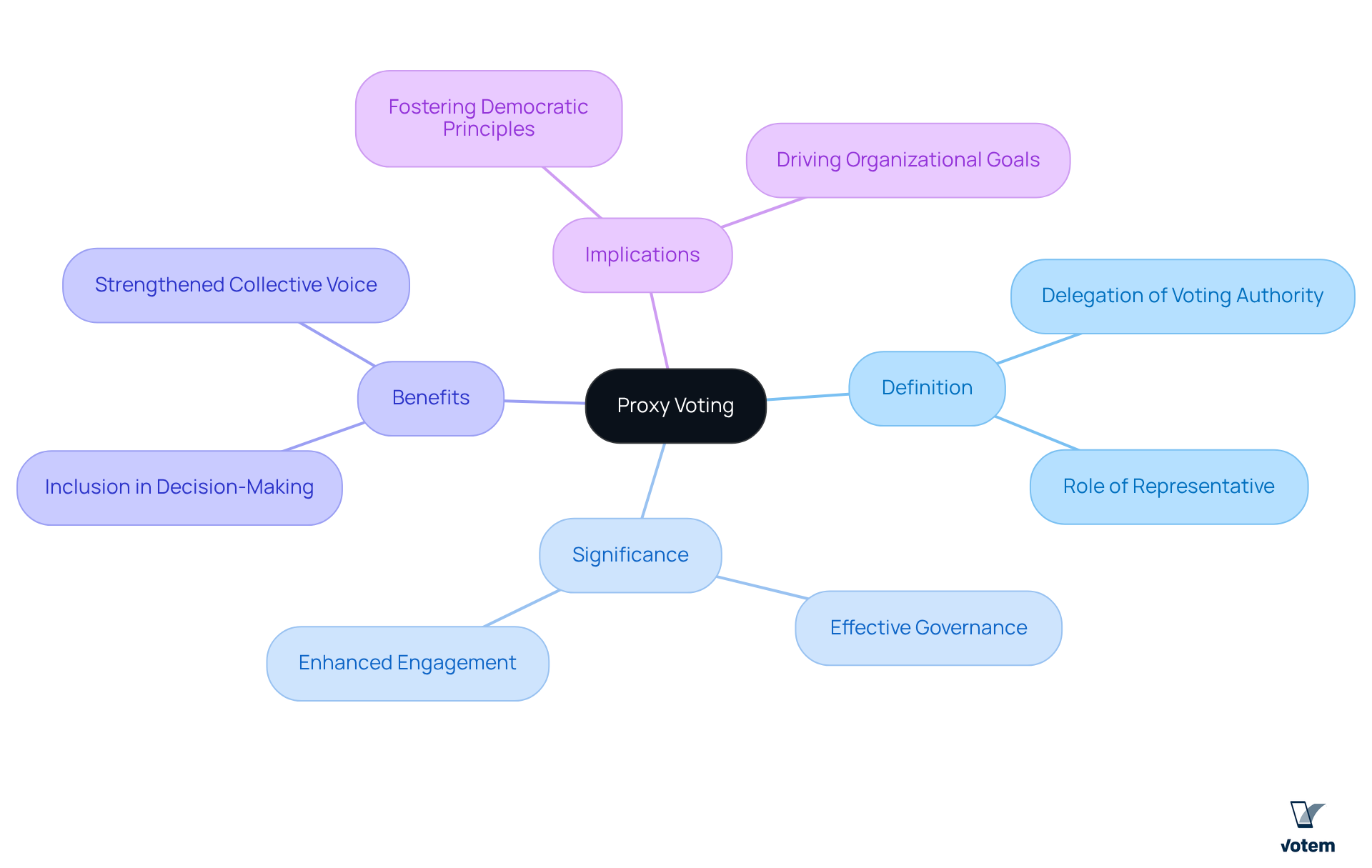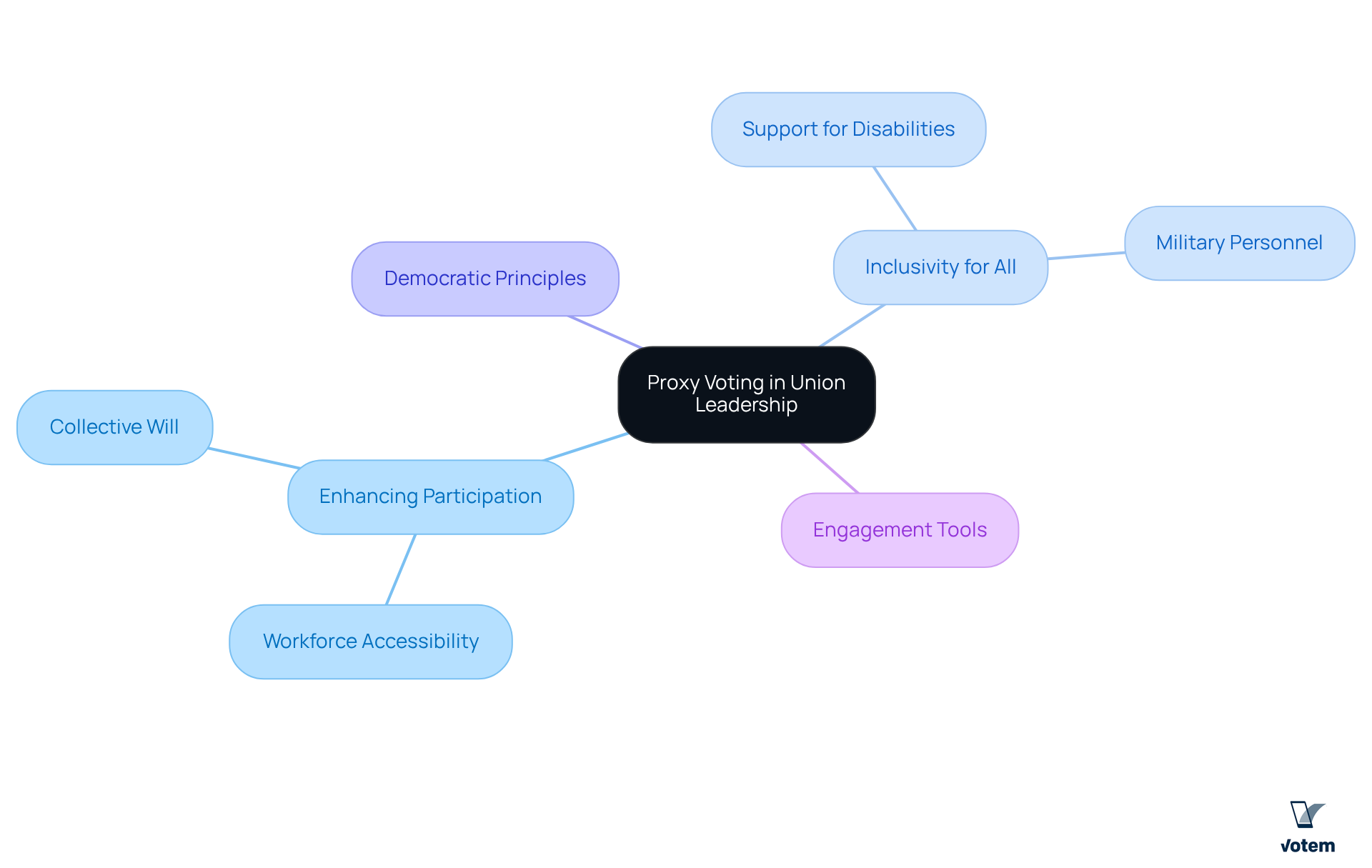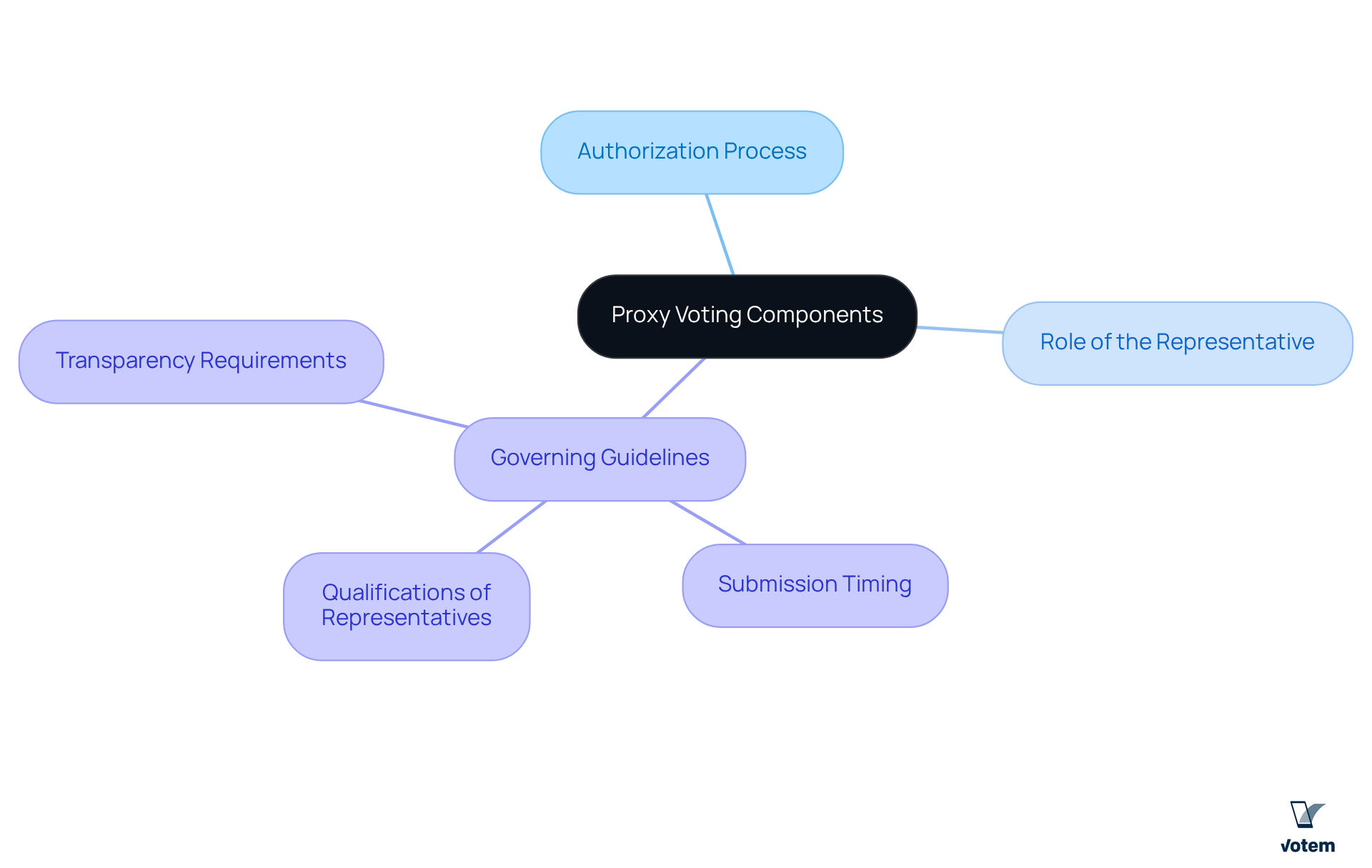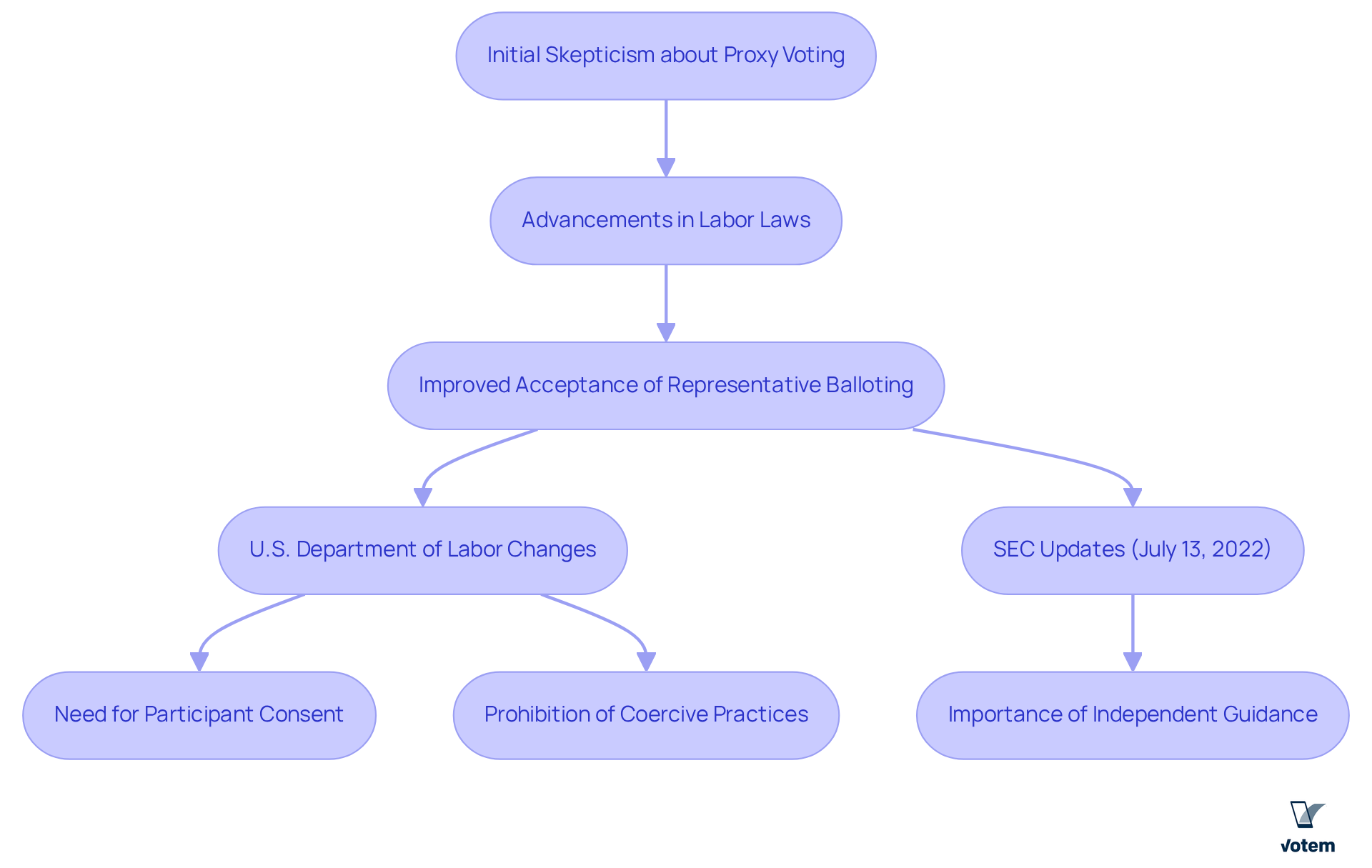Overview
The article defines proxy voting and underscores its significance for union leaders, particularly its role in enhancing member participation in decision-making processes. By allowing individuals to delegate their voting authority, proxy voting fosters inclusivity and upholds democratic principles within unions. Furthermore, it is crucial to establish clear guidelines and adhere to legal frameworks to ensure effective governance.
This mechanism not only empowers union members but also strengthens the overall democratic fabric of union operations. By engaging in proxy voting, members can feel more invested in the outcomes of decisions that affect them, which in turn cultivates a sense of community and shared responsibility. In addition, the implementation of proxy voting can lead to increased turnout and participation, vital for a thriving union.
Union leaders must recognize the importance of these practices and advocate for their adoption. A commitment to clear procedures and legal compliance will not only enhance the legitimacy of the voting process but also build trust among members. This trust is essential for fostering a robust and engaged union membership. Ultimately, embracing proxy voting can transform the way unions operate, promoting a culture of inclusivity and active participation.
Introduction
Understanding the dynamics of decision-making within unions is crucial for effective leadership. Proxy voting emerges as a key mechanism in this context. This practice not only allows members to delegate their voting power when they cannot attend meetings but also reinforces the democratic principles that underpin collective governance.
However, how can union leaders ensure that this system is utilized effectively to enhance participation and representation? Exploring the intricacies of proxy voting reveals not just its definition and significance but also the challenges and evolving legal frameworks that shape its implementation in today’s labor organizations.
Furthermore, by addressing these challenges, union leadership can foster a more inclusive environment that encourages active participation from all members.
Define Proxy Voting: A Comprehensive Overview
The proxy voting definition describes a pivotal method that empowers individuals within decision-making groups, such as unions or corporate boards, to delegate their voting authority to a designated representative. This process ensures that participants can still engage in critical votes, even in their absence from meetings. The representative acts on behalf of the participant, casting votes in alignment with their specific instructions or, at times, exercising discretion based on the participant’s interests.
Furthermore, the significance of proxy voting becomes even more pronounced in collective contexts, where effective governance and representation are essential. By enabling participation from afar, proxy voting not only enhances engagement but also reinforces the democratic principles that underpin these organizations. This practice is crucial for fostering a sense of inclusion and shared decision-making among all members, particularly in scenarios where physical presence may be challenging.
In conclusion, understanding and utilizing the proxy voting definition is vital for union leadership. It not only facilitates participation but also strengthens the collective voice of the group, ensuring that every member’s opinion is considered in the decision-making process. As union leaders, embracing this practice can lead to more effective governance and representation, ultimately driving the organization towards its goals.

Contextualize Proxy Voting: Importance for Union Leadership
The proxy voting definition holds considerable significance for labor leadership, as it enhances participant involvement and engagement in decision-making processes. Many staff members may be unable to attend gatherings due to work responsibilities or other obligations. By allowing participation through the proxy voting definition, organizations can ensure that all opinions are acknowledged, fostering a more inclusive atmosphere.
Furthermore, Votem’s innovative online ballot solutions further enhance this accessibility, enabling eligible voters—including individuals with disabilities and military personnel—to engage effortlessly. This practice not only strengthens democratic principles within the organization but also reinforces the legitimacy of leadership decisions, reflecting the collective will of the membership, which is supported by the proxy voting definition.
Moreover, representative balloting can serve as a powerful tool for rallying members around important issues, thereby enhancing overall participation and involvement in collective activities. With Votem’s established history of managing substantial ballot totals, such as the 299,000 votes collected for the National Radio Hall of Fame, unions can confidently adopt representation methods to improve their electoral processes.

Identify Key Components of Proxy Voting: Characteristics and Guidelines
Key components of representative voting, which align with the proxy voting definition, encompass the authorization process, the role of the representative, and the governing guidelines. Members are required to provide clear written consent for another individual to act on their behalf, as outlined in the proxy voting definition, which can be achieved through a designated form. The representative must cast votes according to the proxy voting definition, ensuring that the member’s directives and preferences are accurately reflected.
Guidelines for representative balloting typically include stipulations regarding:
- Submission timing
- Qualifications of representatives
- Necessity for transparency throughout the process
Furthermore, associations are obligated to comply with applicable labor laws and regulations, which may vary by jurisdiction. Understanding these elements is crucial for union leaders, enabling them to effectively oversee representative decision-making and uphold democratic practices.

Examine the Evolution of Proxy Voting: Legal Framework and Recent Changes
The evolution of representative balloting has been significantly influenced by various legal frameworks and regulatory changes. Initially, representative balloting faced skepticism due to concerns regarding transparency and accountability. However, with advancements in labor laws, the acceptance and regulation of representative ballot practices have improved markedly. Recent changes instituted by the U.S. Department of Labor have clarified the rules governing representation decisions in labor elections, underscoring the necessity of participant consent and explicitly prohibiting coercive practices. These modifications are part of a larger initiative aimed at bolstering democratic governance within organizations and protecting the rights of members.
Furthermore, the SEC’s updates to representation rules, effective July 13, 2022, further emphasize the need for independent and timely guidance in representation matters, as articulated by SEC Chair Gary Gensler. It is imperative for union leaders to remain informed about these developments to adeptly navigate the complexities of representative decision-making and ensure compliance with the evolving legal landscape. In addition, understanding the implications of the proxy voting definition is crucial for maintaining adherence to these new regulations.

Conclusion
Understanding the concept of proxy voting is essential for union leaders. It serves as a crucial mechanism for ensuring that every member’s voice is heard, even when they are unable to attend meetings. This practice not only facilitates participation but also enhances the democratic framework within unions, allowing for a more inclusive decision-making process that reflects the collective will of the membership.
Furthermore, several key insights are highlighted, including:
- The importance of proxy voting in fostering engagement
- The guidelines that govern its implementation
- The evolution of its legal framework
By embracing proxy voting, union leaders can navigate the complexities of representation, uphold democratic practices, and ensure that all members can contribute to critical decisions, regardless of their physical presence.
Ultimately, the significance of proxy voting extends beyond mere participation; it embodies the principles of democracy and collective governance that are vital to the success of any union. As union leaders, prioritizing and effectively implementing proxy voting can lead to stronger representation, enhanced member involvement, and a more unified organization. Embracing this practice is not just a procedural necessity; it is a commitment to fostering a culture of inclusivity and shared decision-making that empowers every member.
Frequently Asked Questions
What is proxy voting?
Proxy voting is a method that allows individuals in decision-making groups, such as unions or corporate boards, to delegate their voting authority to a designated representative. This enables participants to engage in votes even if they cannot attend meetings.
How does proxy voting work?
In proxy voting, a representative casts votes on behalf of a participant based on specific instructions given by the participant or, in some cases, exercises discretion according to the participant’s interests.
Why is proxy voting important in collective contexts?
Proxy voting is significant in collective contexts because it enhances governance and representation. It allows for participation from afar, reinforcing democratic principles and fostering inclusion and shared decision-making among all members.
How does proxy voting promote engagement?
By enabling individuals to participate in votes without being physically present, proxy voting enhances engagement among members, ensuring that their voices are heard in the decision-making process.
What is the impact of proxy voting on union leadership?
Understanding and utilizing proxy voting is vital for union leadership as it facilitates participation and strengthens the collective voice of the group, ensuring that every member’s opinion is considered, ultimately leading to more effective governance and representation.
List of Sources
- Examine the Evolution of Proxy Voting: Legal Framework and Recent Changes
- SEC.gov | SEC Adopts Amendments to Proxy Rules Governing Proxy Voting Advice (https://sec.gov/newsroom/press-releases/2022-120)
- Proxy vote meaning: Complete guide to proxy voting (https://diligent.com/resources/blog/proxy-voting-guidelines)
- Capital Markets & Securities Law Watch (https://winston.com/en/blogs-and-podcasts/capital-markets-and-securities-law-watch/sec-adopts-amendments-to-proxy-voting-rules-to-enhance-the-timeliness-and-independence-of-proxy-voting-advice)

